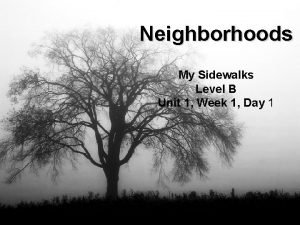Technical English Week 10 Unit 10 Section 1














- Slides: 14

Technical English Week 10: Unit 10 Section 1: Reading Comprehension Shahrood University of Technology English for Civil Engineering Students 1

Vertical Alignment Design Criteria for Streets and Highways • In the analysis of grade and grade control, one of the most important considerations is the effect of grade upon the operating costs of the motor vehicles. An increase in the gasoline consumption and a reduction of speed are apparent when grades are increased. English for Civil Engineering Students 2

• An economical approach would be to balance the added annual cost of grade reduction against the added annual cost of vehicle operation without grade reduction. An accurate solution to the problem depends on the knowledge of traffic volume and type, which can be obtained only by means of a traffic survey. English for Civil Engineering Students 3

• While maximum grades vary a great deal in various states, AASHTO recommendations make maximum grades dependent on design speed and topography. Present practice limits grades in flat country to 6 percent at 30 mph design speed and 3 percent for 80 mph. In mountainous terrain 9 percent at 30 mph and 5 percent at 70 mph should be used. English for Civil Engineering Students 4

• Residential streets, which have the primary function of providing access to land areas and only the secondary function of traffic service, tend to conform to and blend with undulations in the existing terrain. Maximum grades as steep as 15 percent may be permitted for local streets in hilly terrain. English for Civil Engineering Students 5

• Whenever long-sustained grades are used, the designer should not substantially exceed the critical length of grade without the provision of climbing lanes for slowmoving vehicles. Critical grade lengths vary from 1700 feet for a 3 percent grade to 500 feet for an 8 percent grade. English for Civil Engineering Students 6

• Long-sustained grades should be less than the maximum grade used on any particular section of a highway. It is often preferred to break the long sustained uniform grade by placing steeper grades at the bottom and lightening the grades near the top of the ascent. Dips in the profile grade in which vehicles may be hidden from view should also be avoided. English for Civil Engineering Students 7

• Minimum grades are governed by drainage condition. Level grades may be used to fill sections in rural areas when crowned pavements and sloping shoulders can take care of the pavement surface drainage. It is preferred, however, to have a minimum grade of at least 0. 3 percent under most conditions in order to secure adequate drainage. English for Civil Engineering Students 8

• Sight distance. Safe highways must be designed to give the driver a sufficient distance of clear vision ahead so that he can avoid hitting unexpected obstacles and can pass slower vehicles without danger. • Sight distance is the length of highway visible ahead to the driver of a vehicle. When the distance is not long enough to permit passing an overtaken vehicle, it is termed 'stopping (or nonpassing) sight distance. ' English for Civil Engineering Students 9

• The stopping distance is the minimum distance required for stopping a vehicle traveling at or near the design speed before reaching an object in its path. This stationary object may be a vehicle or some other object on the roadway. When the sight distance is long enough to enable a vehicle to overtake and pass another vehicle on a two-lane highway without interference from an oncoming vehicle, it is termed 'passing distance. English for Civil Engineering Students 10

• Minimum Stopping Sight Distance. Sight distance at every point should be as long as possible, but never less than the minimum stopping sight distance. The minimum stopping sight distance is based upon the sum of two distances: one, the distance traveled from the time the object is sighted to the instant that the brakes are applied, and two, the distance required for stopping the vehicle after the brakes are applied. English for Civil Engineering Students 11

• The first of these two distances is dependent upon the speed of the vehicle and the perception time and brake reaction time of the operator. The second distance depends upon the speed of the vehicle; condition of brakes, tires, and roadway surface; and the alignment and grade of the highway. English for Civil Engineering Students 12

• Braking Distance. There is a wide variation among vehicle operators as to the time that it takes to react and to apply the brakes after an obstruction is sighted. Investigations seem to indicate that the minimum value of perception time can be assumed to vary from 2 seconds at 30 miles per hour to 1 second at 70 miles per hour. Brake reaction time is less than perception time, and tests indicate that the average brake reaction time is about ½ second. English for Civil Engineering Students 13

• To provide a factor of safety for operators whose brake reaction time is above average, a full second is assumed as the total brake reaction time. Some investigators feel that perception and brake reaction time should be combined and have assigned 2 ½ seconds for this value. English for Civil Engineering Students 14
 Week by week plans for documenting children's development
Week by week plans for documenting children's development Si vs english units
Si vs english units English 5 quarter 4 week 6-7
English 5 quarter 4 week 6-7 English 9 quarter 2 week 3
English 9 quarter 2 week 3 English week
English week English week objectives
English week objectives Unit 10, unit 10 review tests, unit 10 general test
Unit 10, unit 10 review tests, unit 10 general test Unit 5 wonders of nature week 1
Unit 5 wonders of nature week 1 Diving suit
Diving suit Unit 3 week 4 vocabulary
Unit 3 week 4 vocabulary Asd ste
Asd ste What is technical communication in english
What is technical communication in english Full section drawing
Full section drawing Unit 4 common specialist technical principles
Unit 4 common specialist technical principles Speak theme
Speak theme


























